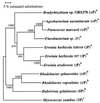Isolation and characterization of canthaxanthin biosynthesis genes from the photosynthetic bacterium Bradyrhizobium sp. strain ORS278
- PMID: 10851005
- PMCID: PMC94561
- DOI: 10.1128/JB.182.13.3850-3853.2000
Isolation and characterization of canthaxanthin biosynthesis genes from the photosynthetic bacterium Bradyrhizobium sp. strain ORS278
Abstract
A carotenoid biosynthesis gene cluster involved in canthaxanthin production was isolated from the photosynthetic Bradyrhizobium sp. strain ORS278. This cluster includes five genes identified as crtE, crtY, crtI, crtB, and crtW that are organized in at least two operons. The functional assignment of each open reading frame was confirmed by complementation studies.
Figures




References
-
- Armstrong A G, Alberti M, Leach F, Hearst J E. Nucleotide sequence, organization, and nature of the protein products of the carotenoid biosynthesis gene cluster of Rhodobacter capsulatus. Mol Gen Genet. 1989;216:254–268. - PubMed
-
- Bramley P M, Mackenzie A. Regulation of carotenoid biosynthesis. Curr Top Cell Regul. 1988;29:291–343. - PubMed
-
- Eaglesham A R J, Ellis J M, Evans W R, Fleischman D E, Hungria M, Hardy R W F. The first photosynthetic N2-fixing Rhizobium: characteristics. In: Gresshoff P M, Roth L E, Stacey G, Newton W L, editors. Nitrogen fixation: achievements and objectives. New York, N.Y: Chapman and Hall; 1990. pp. 805–811.
-
- Felsenstein J. Confidence limits on phylogenies: an approach using the bootstrap. Evolution. 1985;39:783–791. - PubMed
MeSH terms
Substances
Associated data
- Actions
LinkOut - more resources
Full Text Sources
Other Literature Sources

